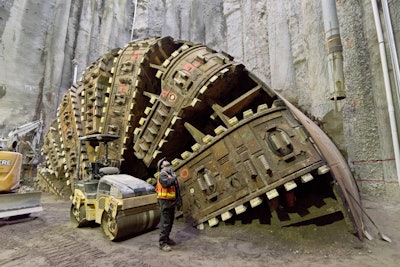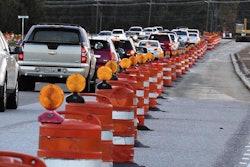 A worker with Seattle Tunnel Partners watches as co-workers are lifted out of Bertha’s repair pit Dec. 15, 2015. With repairs complete, crews filled the hole in in order to begin tunneling with the machine after a 2-year delay. Photo Credit: WSDOT Flickr
A worker with Seattle Tunnel Partners watches as co-workers are lifted out of Bertha’s repair pit Dec. 15, 2015. With repairs complete, crews filled the hole in in order to begin tunneling with the machine after a 2-year delay. Photo Credit: WSDOT FlickrBertha hasn’t been blessed with the best of luck in Seattle, but the world’s largest tunnel boring machine is back to drilling again for now.
The Seattle Tunnel Partners announced that the Washington State Department of Transportation has decided to conditionally lift the suspension for cause that Gov. Jay Inslee enacted in January following the formation of a sink hole and a barge overturning.
The Seattle Times has reported that Bertha bored about three feet in a few hours on the first day back to drilling on Tuesday. STP has been granted permission to drill a total of 160 feet in order to lay 25 more of the 6.5-foot concrete tunnel rings that make the tunnel’s walls.
However, the tunnel’s builders are being asked to show that changes have been made to ensure safety during the dangerous project.
While STP maintained that the suspension was wrongful, the contractors made the following changes as required by WSDOT before the drilling could resume:
- Updated tunnel work and quality plans, including calculations of the amount of soil removed during excavation of each tunnel ring.
- Realignment of key personnel within their quality assurance program.
- New quality assurance protocols.
- New personnel at key positions within the tunneling operation.
- Restructured daily tunneling meetings that include additional participants and protocols.
The changes satisfied acting WSDOT Sec. Roger Millar, who said that lifting the suspension allows STP to prove they’ve made the right changes in order to continue work on the project.
“Above all else, this project has always been about safety,” Millar said. “We must continue our work to replace the viaduct, but we have an obligation to ensure that work proceeds safely. We will continue to work with STP while taking whatever steps are necessary to protect the interests of the public moving forward.”
Going forward, Bertha will continue to drill the 160 feet approved as STP attempts to demonstrate that its revised mining procedures are safe and effective. If everything goes according to plan, STP could then begin drilling another 100 feet until its time for a scheduled maintenance before the drilling proceeds beneath the Alaskan Way Viaduct.
Bertha came to a halt in January 2014, just one-tenth of the way through digging a 1.7-mile tunnel which will replace the Alaskan Way viaduct and carry a double-deck highway beneath Seattle. The project was originally scheduled for completion by the end of this year but has been delayed time and time again by a long list of setbacks.









